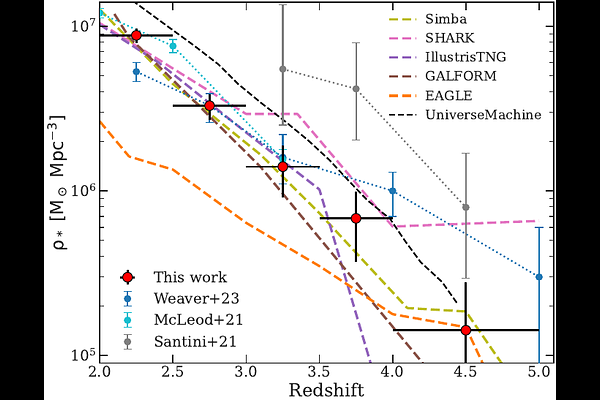Exploring over 700 massive quiescent galaxies at z = 2-7: Demographics and stellar mass functions

Exploring over 700 massive quiescent galaxies at z = 2-7: Demographics and stellar mass functions
William M. Baker, Francesco Valentino, Claudia del P. Lagos, Kei Ito, Christian Kragh Jespersen, Rashmi Gottumukkala, Jens Hjorth, Danial Langeroodi, Aidan Sedgewick
AbstractHigh-redshift ($z>2$) massive quiescent galaxies are crucial tests of early galaxy formation and evolutionary mechanisms through their cosmic number densities and stellar mass functions (SMFs). We explore a sample of 745 massive ($\rm M_*> 10^{9.5}M_\odot$) quiescent galaxies from $z=2-7$ in over 800 arcmin$^2$ of NIRCam imaging from a compilation of public JWST fields (with a total area $>$ 5 $\times$ previous JWST studies). We compute and report their cosmic number densities, stellar mass functions, and cosmic stellar mass density. We confirm a significant overabundance of massive quiescent galaxies relative to a range of cosmological hydrodynamical simulations and semi-analytic models (SAMs). We find that one SAM, SHARK is able to reproduce our observed number density with the addition of mock observational errors, but that it is still unable to produce quiescent galaxies of the same masses. We find that no simulations or SAMs accurately reproduce the SMF for massive quiescent galaxies at any redshift within the interval $z=2-5$. This shows that none of these models' feedback prescriptions are fully capturing high-z galaxy quenching, challenging the standard formation scenarios. We find a greater abundance of lower-mass ($\rm M_*<10^{10}M_\odot$) quiescent galaxies than previously found, highlighting the importance of sSFR cuts rather than simple colour selection. We show the importance of this selection bias, alongside individual field-to-field variations caused by cosmic variance, in varying the observed quiescent galaxy SMF, especially at higher-z. We also find a steeper increase in the cosmic stellar mass density for massive quiescent galaxies than has been seen previously, with an increase of around a factor of 60 from $z=4.5$ to $z=2$, indicating the increasing importance of galaxy quenching within these epochs.